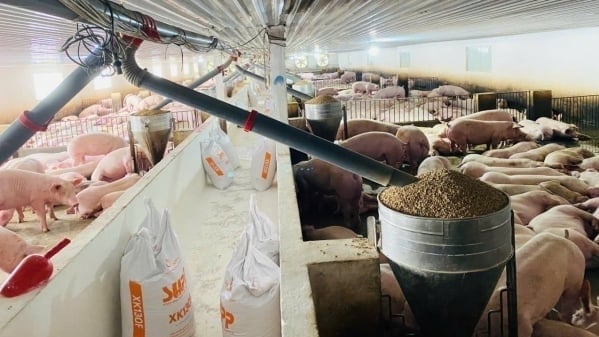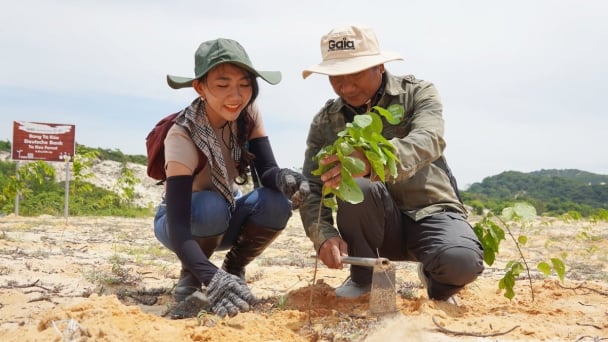September 3, 2025 | 18:34 GMT +7
September 3, 2025 | 18:34 GMT +7
Hotline: 0913.378.918
September 3, 2025 | 18:34 GMT +7
Hotline: 0913.378.918

A pesticide packaging collection site in Dong Thap Province. Photo: Son Trang.
A solution to promoting the recycling of pesticide packaging is the triple-rinse method. This approach method to pesticide packaging is rapidly gaining attention in China, one of the largest pesticide users in the world.
According to Liu Jia Bing, CEO of CropLife China, data from a study sponsored by the Ministry of Agriculture of China in 2019 revealed that pesticide residue in polyester bottles ranged from 1.02% to 3.62% after the initial emptying. On the other hand, pesticide residue in aluminum foil bags ranged from 1.88% to 3.22%.
If farmers rinse the bottles and packaging with water, the level of pesticide residue can drop to below 0.05% after one rinse and reach an undetectable level (below 0.0005%) after three rinses.
Based on these findings, CEO Liu Jia Bing emphasized that triple-rinsing is one of the prerequisites for exempting pesticide packaging from hazardous waste management. Consequently, this adjustment will improve the feasibility of pesticide packaging management efforts and significantly reduce costs. Additionally, the triple-rinse approach enables the reuse of empty packaging, thereby providing economic benefits for the collection and handling of pesticide packaging.
A study in India indicated that the triple-rinsing method eliminates over 99.9% of pesticide residue in the packaging. This figure confirmed that small pesticide containers widely used by Indian farmers meet the criteria for being classified as non-hazardous waste following treatment in the triple-rinsing process.
According to Gabriela Briceno, Stewardship Programs Director at CropLife Latin America, the CampoLimpio program, which manages empty pesticide packaging, in various countries across the region has reclaimed 781,841 tons of empty pesticide packaging over the last thirty years. Accordingly, key steps in the effective implementation of CampoLimpio include triple-rinsing, puncturing containers, and sorting the waste.
Steven Byrde, a consultant on pesticide packaging management for CropLife Europe and CropLife International, affirmed that thoroughly rinsing and drying empty pesticide containers is essential to the effectiveness of collection and recovery systems for pesticide packaging.
As a result, policy advocacy for pesticide packaging management in various countries should include regulations on the appropriate rinsing method. Accordingly, farmers can be required to rinse, puncture, and return empty pesticide containers with properly rinsed packaging classified as non-hazardous waste. Furthermore, local governments should provide incentives to encourage farmers to rinse and return their pesticide packaging.

Farmers participating in the collection of pesticide packaging. Photo: Son Trang.
Triple-rinsing is an effective solution for managing pesticide packaging. However, the design of many packaging types poses as a significant challenge to the rinsing process, especially in Asian countries.
Dr. Andreas Thierfelder from CropLife International noted that soft pesticide packaging (such as pouches and bags) accounts for approximately 20% to 50% of pesticide packaging in East Asia, South Asia, and Southeast Asia.
While the level of pesticide residue in rigid containers typically ranges from 1 to 5% after use, these figures can be significantly higher in soft packaging. The common design of soft packaging prevents safe and thorough rinsing, making it unsuitable to classify as non-hazardous waste.
At present, there is a lack of recycling or recovery options for hazardous pesticide packaging. Chemical recycling for hazardous pesticide waste packaging is a solution currently subject to thorough consideration. Incineration or destruction of said packaging must meet national and international legal requirements for dangerous waste management.
The limited recycling options and the high costs associated with incineration or co-processing create challenges in managing hazardous soft pesticide packaging waste in Asia.
Consequently, Dr. Andreas Thierfelder suggested that the ability to properly rinse all types of pesticide packaging should be regulated by legal frameworks involving pesticide management. Extended producer responsibility (EPR) is a potential tool to enforce higher quality standards, ensuring that all pesticide packaging can be rinsed thoroughly. Additionally, chemical recycling can emerge as a potential alternative technology for recycling hazardous packaging.
According to CropLife International, the global pesticide industry has developed a series of safety measures and guidelines to ensure the safe and controlled recycling of materials from pesticide packaging. Accordingly, only rinsed and monitored packaging is eligible for recycling. Moreover, the triple-rinse process helps eliminate up to 99.99% of pesticide residue from the packaging.
Translated by Nguyen Hai Long
/2025/09/03/1620-3-160956_644.jpg)
(VAN) Under global requirements, Vietnam is urgently finalizing measurement tools, ensuring data transparency, and completing a legal framework to transform its forest potential into a sustainable resource.

(VAN) Amid the African swine fever ‘storm’, large-scale livestock farms in Lao Cai remain safe thanks to strict biosecurity practices.
/2025/09/02/2302-5-070350_276.jpg)
(VAN) Prof. Dr. Pham Hong Giang, former Deputy Minister of Agriculture and Rural Development, shared his unforgettable memories of constructing large reservoirs and dams in Central Vietnam.
/2025/09/01/2628-2-151932_465.jpg)
(VAN) From the Da Nhim forests with 'wildlife trap-removal knights' to Cuc Phuong National Park, conservation has become a pivotal shift, shaping a modern Vietnamese forestry.

(VAN) The dugong population in Con Dao has been steadily declining due to multiple causes, raising urgent demands for seagrass meadow restoration and tighter control of human impacts.

(VAN) From seedlings to forest carbon maps, science and technology are becoming the 'brain' and 'heart' that guide forestry toward sustainable development and deeper integration into global supply chains.

(VAN) Vietnam is increasingly vulnerable to the impacts of climate risks and natural disasters. Without timely adaptation measures, climate change could cause the nation’s GDP to shrink significantly.